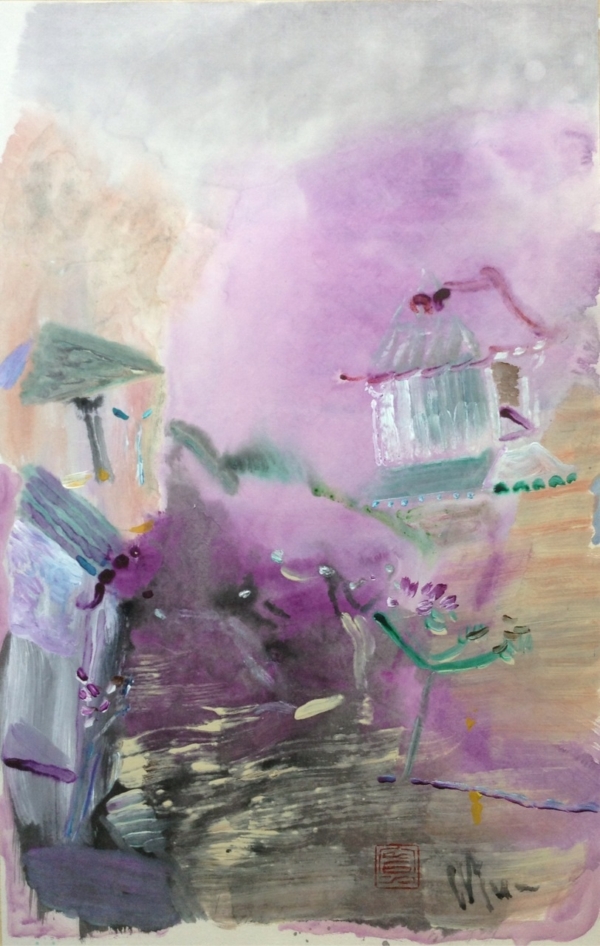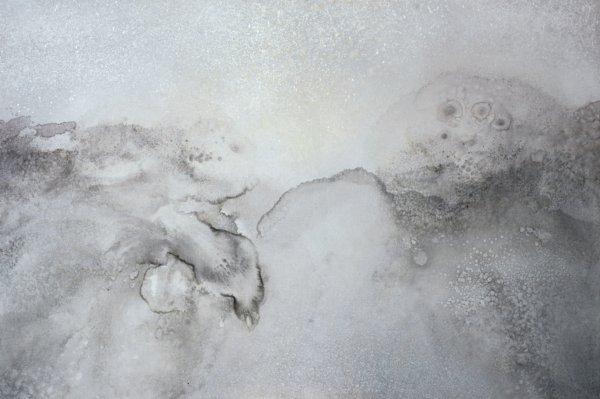Leng Hong & Michel Braun
“ DREAM OF A BUTTERFLY „( RÊVE D’UNE PAPILLON l TRAUM VON EINEM SCHMETTERLING)
Leng Hong and Michel Braun , Duo Exhibition (Acrylic, Chinese Ink and Oil)
14 January- 29 March 2021
TRAUM VON EINEM SCHMETTERLING
Duo Ausstellung Leng Hong und Michel Braun
Aus einem Traum aufwachend, in dem der Taoist Zhuang Zou (3. Jahrhundert v. Chr.), war, fragt er sich, ob es nicht eher ein Schmetterling sei, der weiter davon träumt, ein Mensch zu sein. Mit diesem Gedanken stellt er die Frage nach der Realität und der Illusion.
Dreiundzwanzig Jahrhunderte später greift Chagall diese Reflexion erneut auf, indem er erklärt, dass „die Malerei ein Fenster öffnet, durch das man in eine andere Welt fliegen kann; unsere gesamte Innenwelt ist ebenfalls Realität, vielleicht sogar realer als die sichtbare Welt. “
Leng Hong, der sich von Chagall, aber auch von Picasso, Matisse und Giotto inspirieren ließ, stellt den Traum in den Mittelpunkt seines Kunstwerkes, indem er die Gegenüberstellung mehrerer expressionistischer Perspektiven in mehreren Schattierungen auf derselben Leinwand brillant einsetzt. Leng Hong, der in der reinster chinesischen Tradition geschult, ist auch ein Liebhaber der Poesie /Dichtung, die er sich zu Eigen macht, um sie in sein Inneres zu integrieren und in seinen Aquarellen wiederzugeben.
Ihm zufolge, „ist das Malen der Landschaft des Körpers oder das Malen der Haut der Träume immer das Malen seiner inneren Landschaft „. Diese Aussage erinnert an die
eines Künstlers der Tang-Dynastie, der sagte, „ein klassisches Gedicht sei voller Bilder.“ Die Verse, die man liest, oft vor langer Zeit, werden zu einem Teil von einem selbst und irgendwann zu dem, was man malt. “
Michel Braun hat sich dazu entschieden, zu den Quellen der chinesischen Kunst und zur Ausdruckskraft der Linie in Tusche zurückzukehren. Tatsächlich „malt“ Michel Braun nicht, sondern schreibt „Gemälde“, wie der Künstler Wang Wei (im 13. Jahrhundert) beschreibt. Wie jeder gute Reisende, „der nicht weiß, wohin er geht und keine Absicht hat, anzukommen“ (Lao Tseu), schafft Michel Braun Werke, in denen alles in Bewegung und Wandel ist, wie Gedichte ohne Worte.
In seinem Kunstwerk entstehen durch den Wechsel von Festkörpern und Leerstellen unberührte Räume, die zum Atmen Atmung drängend und die Bewegung innerhalb des Gemäldes erzeugen. Dieser Effekt wird durch, den Kontrast zwischen Tusche und Untergrund, dem Gegensatz zwischen Schwarz und Weiß unterstrichen und verstärkt.
Die Leere in Michel Braun Werk, in Form von Rauch, Wolken oder unsichtbaren Luftzügen führt alles zu einem verborgenen Wandel. Anstatt, den Raum zu „verflüchtigen“, gibt diese Leere dem Bild eine Einheit, in der alles wie in einer organischen Struktur atmet.
Die Gemälde von Leng Hong entsprechen, wie die von Michel Braun, vollkommen der Definition, die der Mönch Bitterer Kürbis für die ideale Ästhetik im 17. Jahrhundert (die Einheitslinie) gegeben hat: „Die Malerei muss die Metamorphose der Welt, die wesentliche Schönheit der Berge und Flüsse, die ständige Aktivität des Schöpfers und den lebendige Einströmen des Atems von Yin und Yang zum Ausdruck bringen. Mit Pinsel und Tusche ergreift sie alle Geschöpfe des Universums und singt ihre Freude in mir“.
REVE D’UN PAPILLON
Exposition duo des artistes Leng Hong et Michel Braun
Le taoïste Zhuang Zou (3eme siècle avant JC), sort d’un rêve où il s’est vu papillon, se demande s’il n’est pas plutôt un papillon continuant à rêver qu’il est un homme, posant ainsi la question du réel et de l’illusion.
Vingt-Trois siècles plus tard, Chagall reprend cette réflexion en déclarant que « la peinture ouvre une fenêtre par laquelle s’envoler vers un autre monde; tout notre monde intérieur est aussi la réalité, peut-être même plus réelle que le monde visible ».
Leng Hong, inspiré pas Chagall, mais aussi par Picasso, Matisse et Giotto, replace le rêve au cœur de son œuvre, avec son utilisation brillante de la juxtaposition de plusieurs perspectives expressionnistes à plusieurs nuances sur une même toile. Leng Hong, lettré dans la plus pure tradition chinoise, est aussi amateur de poésies qu’il assimile pour les intégrer à son moi intérieur et les restituer dans ses aquarelles.
D’après lui, « peindre le paysage du corps ou peindre la peau des rêves, c’est toujours dessiner son paysage intérieur ». Cette affirmation fait écho à celle d’un artiste de la dynastie Tang selon qui « un poème classique est empli d’images. Les vers que vous avez lus, souvent il y a bien longtemps, deviennent une partie de vous-même et, à un moment donné, deviennent ce que vous peignez. »
Michel Braun, pour sa part, a choisi de revenir aux sources de l’art chinois et à la puissance d’expression du trait à l’encre de chine. De fait, Michel Braun ne « peint » pas, mais plutôt, selon l’artiste Wang Wei (au 13ème siècle) « écrit des peintures ».
En effet, comme tout bon voyageur « qui ne sait pas où il va et n’a pas l’intention d’arriver» (Lao Tseu), Michel Braun propose des œuvres où tout est mouvement et mutations, comme des poésies sans paroles.
Dans son œuvre, l’alternance de pleins et de vides ménagent des espaces vierges qui imposent une respiration et qui incitent à circuler dans le tableau, tandis que le contraste entre encre et support, l’opposition entre les noirs et les blancs, soulignent et augment cet effet.
Le vide, dans le travail de Michel Braun, sous forme de fumées, de nuages ou de souffles invisibles, porte toute chose vers de secrètes mutations. Loin de « diluer » l’espace, ce vide confère au tableau une unité où toute chose respire comme dans une structure organique.
Les peintures de Leng Hong, comme celle de Michel Braun, répondent parfaitement à la définition que le moine « Citrouille amère » (au 17ème siècle) donne de l’esthétique idéale ( le trait unitaire) ; « la peinture doit exprimer la métamorphose du monde, la beauté essentielle des monts et des fleuves, l’activité permanente du créateur, l’influx vital du souffle du Yin et Yang ; Par le truchement du pinceau et de l’encre, elle saisit toutes les créatures de l’univers, et chante en moi son allégresse »
DREAM OF A BUTTERFLY
Leng Hong and Michel Braun duo exhibition
The Taoist Zhuang Zou (3rd century BC), comes out of a dream where he saw himself as a butterfly, wonders if it is not rather a butterfly continuing to dream that he is a man, thus asking the question of the reality and the illusion.
Twenty-three centuries later, Chagall takes up this reflection by declaring that “painting opens a window through which to fly away to another world; our entire interior world is also reality, perhaps even more real than the visible world ”.
Leng Hong, inspired by Chagall, but also by Picasso, Matisse and Giotto, places the dream at the heart of his work, with his brilliant use of the juxtaposition of several expressionist perspectives in several shades on the same canvas. Leng Hong, a scholar in the purest Chinese tradition, is also a lover of poems that he assimilates to integrate them into his inner self and restore them in his watercolors.
According to him, „to paint the landscape of the body or to paint the skin of dreams, it is always to draw its interior landscape“. This statement echoes that of a Tang dynasty artist who said “a classical poem is full of images. The verses you read, often a long time ago, become a part of yourself and at some point become what you paint. “
Michel Braun, for his part, chose to return to the sources of Chinese art and to the power of expression of the line in chinese ink. In fact, Michel Braun does not „paint“, but rather, according to the artist Wang Wei (in the 13th century) „writes paintings“.
Indeed, like any good traveler „who does not know where he is going and has no intention of arriving“ (Lao Tseu), Michel Braun offers works where everything is movement and mutations, like poems without words.
In his work, the alternation of full and empty spaces create blank spaces that impose a breath and incite to circulate in the painting, while the contrast between ink and support, the opposition between blacks and whites, underline and increase this effect.
in the work of Michel Braun, emptiness n the form of smoke, clouds or invisible breaths, carries everything towards secret mutations. Far from “diluting” the space, this void confers on the painting a unity where everything breathes as in an organic structure.
Leng Hong’s paintings, like those of Michel Braun, perfectly meet the definition that the monk „Bitter Pumpkin“ (in the 17th century) gives of ideal aesthetics (the unitary line); “the painting must express the metamorphosis of the world, the essential beauty of mountains and rivers, the permanent activity of the creator, the vital influx of the breath of Yin and Yang; By the means of the brush and the ink, it seizes all the creatures of the universe, and sings in me its joy ”


